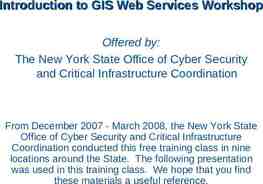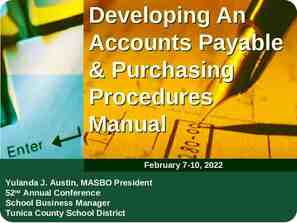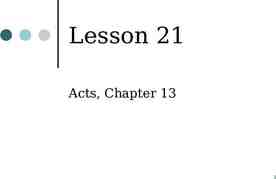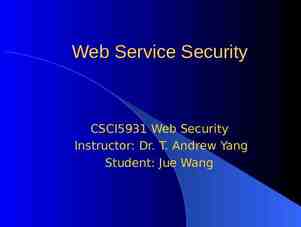Measuring and Simulating T1 and T2 for Qubits Rahaf Youssef
25 Slides2.16 MB

Measuring and Simulating T1 and T2 for Qubits Rahaf Youssef Supervisor: Dr. Adam Lyon SIST Final Presentation 05 08 2020

Why Quantum Computing? Classically, Prime factors of 17 are 2 08/05/20 Rahaf Youssef Measuring and Simulating T 1 and T2 for Qubits

Why Quantum Computing? Classically, Prime factors of 17 are 1, 17 3 08/05/20 Rahaf Youssef Measuring and Simulating T 1 and T2 for Qubits

Why Quantum Computing? Classically, Prime factors of 17 are 1, 17 Prime factors of 91 are 4 08/05/20 Rahaf Youssef Measuring and Simulating T 1 and T2 for Qubits

Why Quantum Computing? Classically, Prime factors of 17 are 1, 17 Prime factors of 91 are 1, 91, 7, 13 5 08/05/20 Rahaf Youssef Measuring and Simulating T 1 and T2 for Qubits

Why Quantum Computing? Classically, Prime factors of 17 are 1, 17 Prime factors of 91 are 1, 91, 7, 13 Prime factors of 232-digit number? 6 08/05/20 Rahaf Youssef Measuring and Simulating T 1 and T2 for Qubits

Why Quantum Computing? Classically, Prime factors of 17 are 1, 17 Prime factors of 91 are 1, 91, 7, 13 Prime factors of 232-digit number? Requires 2 years to find and sizeable amount of money! 7 05/08/20 Rahaf Youssef Measuring and Simulating T 1 and T2 for Qubits

Why Quantum Computing? Classically, Prime factors of 17 are 1, 17 Prime factors of 91 are 1, 91, 7, 13 Prime factors of 232-digit number? Require 2 years to find and sizeable amount of money! The time grows exponentially as the integers increase: 8 08/05/20 Rahaf Youssef Measuring and Simulating T 1 and T2 for Qubits

Why Quantum Computing? Quantum-mechanically, Shor’s algorithm scales according to Can factorize large numbers in a reasonable time thanks to superposition. 9 08/05/20 Rahaf Youssef Measuring and Simulating T 1 and T2 for Qubits

Why Does it Matter? 10 01/20/20 23 Presenter Presentation Title or Meeting Title

The security of online transactions assumes the impossibility of factoring large numbers in a reasonable time using classical algorithms. 11 01/20/20 23 Presenter Presentation Title or Meeting Title

What Makes Up a Quantum Computer? 1) Qubits: basic building block of information. 2) Quantum gates: operations performed on qubits. 3) Measurement: observing the state of the qubit. 12 08/05/20 Rahaf Youssef Measuring and Simulating T 1 and T2 for Qubits

What Makes Up a Quantum Computer? 1) Qubits: the quantum version of classical bits. They are realized by a two-state device i.e. spin up and spin down, or the vertical and horizontal polarization of a single photon, or ground and excited states. This allows for superposition and interference to happen, providing enormous computational power. 13 08/05/20 Rahaf Youssef Measuring and Simulating T 1 and T2 for Qubits

What Makes Up a Quantum Computer? The anharmonicity of the system allow for the first two energy levels to be well separated from higher energy levels. 14 08/05/20 Rahaf Youssef Measuring and Simulating T 1 and T2 for Qubits

What Makes Up a Quantum Computer? 2) Quantum Gates: are unitary matrices such that They are represented as rotations on the Bloch Sphere. 15 08/05/20 Rahaf Youssef Measuring and Simulating T 1 and T2 for Qubits .

What Makes Up a Quantum Computer? 3) Measuring the System: classical resources are needed to obtain the results of the computation. Measurement collapses the wavefunction to a classical state that can be read. The qubit is coupled to a resonator. Measuring the resonance frequency of the resonator indicates the qubit state. 16 08/05/20 Rahaf Youssef Measuring and Simulating T 1 and T2 for Qubits

Are We There Yet? 17 01/20/20 23 Presenter Presentation Title or Meeting Title

No, because of quantum noise! 18 01/20/20 23 Presenter Presentation Title or Meeting Title

Quantum Noise T1 for Qubits 19 08/05/20 Rahaf Youssef Measuring and Simulating T 1 and T2 for Qubits T2 for Qubits

Tools In order to measure and simulate T1 and T2, the following tools were used: 1) Qiskit: an open-source software development kit to prepare, run, and measure quantum states on IBM’s quantum computers. The used model of computation is quantum circuits, where quantum algorithms consist of consecutive gates. 2) QuTip: an open-source Python-based software for simulating the dynamics of noisy quantum systems. 20 08/05/20 Rahaf Youssef Measuring and Simulating T 1 and T2 for Qubits

Using Qiskit (Real Quantum Computer) Measuring T1 on ibmqx2 in μs. 21 08/05/20 Rahaf Youssef Measuring and Simulating T 1 and T2 for Qubits

Using QuTip (Simulation) Simulating T1 using Mesolve 22 08/05/20 Simulating T1 for higher energy levels using Mesolve Rahaf Youssef Measuring and Simulating T 1 and T2 for Qubits

Using Qiskit (Real Quantum Computer) Measuring T2 on ibmqx2 in μs. 23 08/05/20 Measuring T2 on ibmqx2 in μs. Rahaf Youssef Measuring and Simulating T 1 and T2 for Qubits

Using QuTip (Simulation) Simulating T2 using Mesolve 24 08/05/20 Rahaf Youssef Measuring and Simulating T 1 and T2 for Qubits

Thank You! I would like to thank my advisor, Dr. Adam Lyon, the SIST committee, Fermi National Accelerator Laboratory and the United States Department of Energy. 25 08/05/20 Rahaf Youssef Measuring and Simulating T 1 and T2 for Qubits






